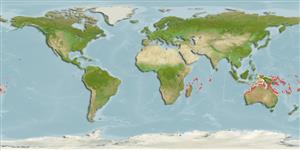Environment: milieu / climate zone / depth range / distribution range
Ecologia
marino associati a barriera corallina; distribuzione batimetrica 5 - 30 m (Ref. 48635). Tropical; 0°S - 29°S, 32°E - 170°W
Indo-West Pacific: three known specimens from Natal, South Africa (Ref. 4315); also from north and northwestern Australia, and possibly extending to western Papua New Guinea. Reported from Samoa (Ref. 592).
Size / Peso / Age
Maturity: Lm ? range ? - ? cm
Max length : 10.0 cm TL maschio/sesso non determinato; (Ref. 2334)
Short description
Chiavi di identificazione | Morfologia | Morfometria
Spine dorsali (totale) : 9; Raggi dorsali molli (totale) : 11 - 111; Spine anali: 0; Raggi anali molli: 11. Pale tan in color, whitish below; back crossed by a broad dark band at spiny dorsal and 2-3 smaller dark bands posteriorly; prominent black blotch on pelvic fins (Ref. 4315).
Inhabits coastal mud or sand channels and slopes (Ref. 48635). Feeds mainly on crabs, prawns, and also fish. Generally not used food (Ref. 2334).
Life cycle and mating behavior
Maturità | Riproduzione | Deposizione | Uova | Fecundity | Larve
Kailola, P.J., 1987. The fishes of Papua New Guinea: a revised and annotated checklist. Vol. II Scorpaenidae to Callionymidae. Research Bulletin No. 41, Research Section, Dept. of Fisheries and Marine Resources, Papua New Guinea. (Ref. 6192)
IUCN Red List Status (Ref. 130435: Version 2024-1)
Threat to humans
Harmless
Human uses
Strumenti
Special reports
Download XML
Fonti Internet
Estimates based on models
Preferred temperature (Ref.
123201): 24.7 - 29.3, mean 28 °C (based on 1551 cells).
Phylogenetic diversity index (Ref.
82804): PD
50 = 0.5039 [Uniqueness, from 0.5 = low to 2.0 = high].
Bayesian length-weight: a=0.00457 (0.00230 - 0.00908), b=3.09 (2.91 - 3.27), in cm total length, based on LWR estimates for this (Sub)family-body shape (Ref.
93245).
Trophic level (Ref.
69278): 3.9 ±0.67 se; based on food items.
Resilienza (Ref.
120179): Alto, tempo minimo di raddoppiamento della popolazione meno di 15 mesi (Preliminary K or Fecundity.).
Fishing Vulnerability (Ref.
59153): Low vulnerability (10 of 100).
